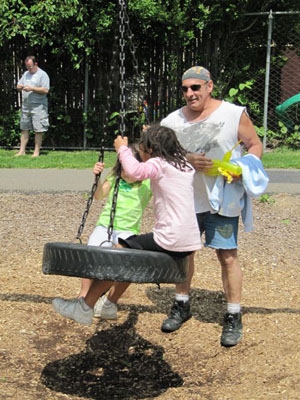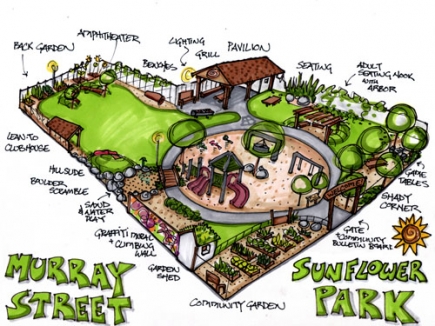Healthy Neighborhoods, Healthy Kids
Dave Tanenhaus is worried about the future of his hometown. As a fourth generation resident of Binghamton, New York, and executive director of Binghamton’s housing authority, he’s watched his city of 50,000 residents transform from a thriving upstate New York community with a strong manufacturing base to one with a shrinking population and rising crime rates. Like other towns around the U.S. hit by the current economic downturn, Binghamton is experiencing an increase in drug use and delinquency among its youth, which troubles Tanenhaus.
“The neighborhoods are deteriorating,” he says. “There are a lot of people working hard to improve the quality of life here. But even with all of that, there’s more acting out among kids as time goes on.”
But recently Tanenhaus has found support from an unusual source: an evolutionary biologist who has studied microbes, zooplankton, and birds.
 "Kids who are more pro-social come from neighborhoods where people know each other,” says evolutionary biologist David Sloan Wilson, who runs the Binghamton Neighborhood Project.
"Kids who are more pro-social come from neighborhoods where people know each other,” says evolutionary biologist David Sloan Wilson, who runs the Binghamton Neighborhood Project.
The biologist, David Sloan Wilson, a professor at the State University of New York (SUNY)’s Binghamton campus, heads the Binghamton Neighborhood Project (BNP), a unique collaboration between researchers and community members.
The BNP draws on the latest research from a variety of academic disciplines to understand why certain neighborhoods thrive—and how to improve those that don’t. The project rests on the assumption that, more than any single influence on a child or community, it is a confluence of forces—the entire culture of a neighborhood, as shaped by parents, schools, and involved community members like Tanenhaus—that truly fosters healthier kids and more positive neighborhoods.
The program is part of a growing trend of “whole-neighborhood” projects around the country that seek more comprehensive ways to improve the lives of children in impoverished communities. This approach has been made famous, in part, by the Harlem Children’s Zone (HCZ), a program that coordinates multiple social and educational services for residents in a 100-block radius of Harlem to help their youth stay in school and out of trouble. The success of HCZ inspired the Obama Administration to introduce the Promise Neighborhoods Initiative, a program offering one-year grants to support non-profit and community-based organizations in developing similar programs. With its multidisciplinary approach, the BNP is uniquely poised to shed light on how forces in a community can combat the negative effects of poverty and violence on children.
While it may seem unusual for an evolutionary biologist to be at the helm of a project like BNP, Wilson is an expert on the evolutionary roots of altruism and cooperation—or “pro-sociality”—and he believes that fostering these traits among youth may hold the key to helping Binghamton. Wilson founded the BNP, in part, to discover what factors impact a neighborhood’s social environment to increase pro-sociality among its residents and decrease problem behaviors, like violence and drug use, among its adolescents. And he is working with community leaders, like Tanenhaus, to put his findings into action to help solve the city’s problems.
Why people are like plants
Studying altruism and cooperation in the face of Binghamton’s serious social problems might seem naïve. But research has shown that pro-sociality in adolescents corresponds with a number of crucial positive outcomes.
In a 2008 study of 457 teens published in the Journal of Happiness Studies, Carolyn Schwartz and her colleagues found that altruistic behavior was associated with higher self-esteem and better social relationships in boys and better physical health and sense of purpose in girls. As bioethicist Stephen Post of Stony Brook University reports in the introduction to a book he edited in 2007, Altruism and Health, kids who perform pro-social behavior are more engaged, less depressed, and, in some cases, physically healthier. Studies have also found that teenagers who volunteer are less likely to fail a subject in school, get pregnant, or abuse alcohol or drugs.
Part of what Wilson and his team hope to understand is how pro-sociality spreads throughout a community. What is it about families, schools, and neighborhoods that can support more altruistic behavior? As an evolutionary biologist, Wilson understands the ways in which physical environments can shape physical traits, and he sees a parallel in how social traits develop and propagate.
 Binghamton community members at a brainstorming party to gather ideas for rebuilding a neighborhood park, part of the BNP's "Design Your Own Park" project.Binghamton Neighborhood Project
Binghamton community members at a brainstorming party to gather ideas for rebuilding a neighborhood park, part of the BNP's "Design Your Own Park" project.Binghamton Neighborhood Project“People are like plants,” he says. “If they live in a harsh environment, they will adapt to the harsh environment.”
To measure levels of pro-sociality in Binghamton adolescents, Wilson’s team administered a survey to thousands of middle school and high school students, asking them to respond to statements such as “I tell the truth even when it is not easy” or “I am serving others in my community.” The survey also measured the amount of support kids receive from their schools, families, religious institutions, and neighborhoods.
Results from the survey were mapped onto the city according to where the student lived. Wilson found that teens with higher pro-sociality scores tended to cluster in particular neighborhoods, and that the supportive quality of one’s neighborhood affected pro-sociality as much or more than a student’s extracurricular activities or religion. Though parents and teachers also influence pro-sociality, the researchers determined that neighborhood culture had a separate and significant impact. Interestingly, the neighborhoods with highly pro-social kids were not necessarily more affluent but the ones where kids believed that adults looked out for them.
“What we found over and over again is that kids who are more pro-social come from neighborhoods where people know each other and there are norms for good behavior,” says Wilson. “Kids know that if they are out in the street misbehaving, a neighbor will call the police or tell their parents.”
To test whether this kind of neighborhood quality could be objectively measured—beyond the student’s impressions—Wilson’s team designed an unconventional study: They dropped stamped, addressed letters in different neighborhoods all over the city and recorded how many were picked up and mailed. The delivery rate gave them a numerical measure of altruism from each neighborhood. Sure enough, delivery rates were higher in neighborhoods that kids had deemed more supportive.
According to Wilson, this study indicates a real culture of caring in these neighborhoods, one that gives kids who live there an advantage.
“Nurturance is huge,” he says. “If you’re a kid and you have it, you have multiple assets.”
Emphasize the positive
Many researchers have looked to schools and families as important influences on children’s lives. But few have looked at whole neighborhoods, in part because the data seemed too dense and complicated to sort through.
Wilson hopes to overcome those hurdles with the BNP model. Already he has gathered data from research studies in other fields, such as economics, anthropology, and social psychology, as well as several Binghamton community resources––the public health department, schools, and the juvenile justice system––and mapped it all onto Binghamton using GIS technology, which allows multiple data sets to be superimposed on a geographic area of the city. He is using this data to see how pieces of the community puzzle are linked together, and how neighborhoods influence public health and community well-being on many levels.
 The design for Sunflower Park, developed through the BNP's "Design Your Own Park" project. The BNP is now helping to build it, in collaboration with the city and the United Way of Broome County.Binghamton Neighborhood Project
The design for Sunflower Park, developed through the BNP's "Design Your Own Park" project. The BNP is now helping to build it, in collaboration with the city and the United Way of Broome County.Binghamton Neighborhood ProjectAccording to Tony Biglan, a senior scientist at theOregon Research Institute and former president of the Society for Prevention Research, Wilson’s approach is revolutionary.
Biglan recently wrote a report for the National Academies’ Institute of Medicine evaluating the effectiveness of numerous school and community intervention programs that are aimed at decreasing anti-social behavior among adolescents. But reading Wilson’s book Darwin’s Cathedral and later meeting him at a conference got Biglan thinking differently about his research.
“We shouldn’t be focusing only on how to prevent social ills,” he says. “We should focus on what people can do to care more about each other and to have increased well-being.”
All of the problem behaviors Biglan studies, he says, stem from the same kinds of social environments, where violence is prevalent and people don’t act or communicate in positive ways. Kids who grow up in families characterized by high levels of criticism and coercive punishments often struggle with self-esteem and turn to drugs, crime, or other anti-social behavior. But when parents use calm, caring, and clear communication with their children, they foster positive development.
Biglan believes there is a parallel process going on in communities: If communities become sources of non-coercive, positive interactions, they can impact entire adolescent populations. “We must find ways to create communities where caring, listening, and supportive behaviors are prevalent,” he says.
Fortunately, adds Biglan, there’s growing evidence that such community-wide interventions can positively impact large-scale populations.
He points to research at John Hopkins University on the Good Behavior Game, a classroom management technique used by teachers to reward attentive behaviors and discourage disruptive behaviors in class. After researchers taught first- and second-grade teachers all over Baltimore to use the technique, they found that not only did student disruptions decrease in those classrooms using the Good Behavior Game, but, by the sixth grade, the kids who received the program were less likely to smoke, be suspended from school, or have other behavioral problems. Even years after the intervention, cocaine use was down by 75 percent and suicide was reduced among teenagers who learned this game as children.
In another community-wide experiment led by Ron Prinz of the University of Southern California, positive parenting programs were offered widely to parents in 18 counties in Ohio, causing significant reductions in cases of child maltreatment and in the number of children sent to foster care.
“This kind of research on neighborhoods is the new frontier,” says Biglan. “We need to find programs like these that inoculate kids against negative behavioral consequences.”
Then there’s the renowned Harlem Children’s Zone. Armed with the motto “Whatever it takes” and generous donations, the HCZ works on multiple levels to improve the lives of kids in the area, from helping pregnant mothers get good prenatal care to teaching parents how to communicate with their children to starting charter schools. Results have been impressive: Last spring, 100 percent of third graders in HCZ charter schools tested at or above their grade level in math, outperforming their peers around the state, and 91 percent of the kids graduating from high school who received after-school support from an HCZ program called TRUCE were accepted to college.
A better way?
Wilson wonders about the practicality of applying HCZ intensive care to all problem neighborhoods. For one thing, HCZ spends over $19,000 per student, or about $3,000 more than the state’s average, to achieve these results. In difficult economic times, that kind of spending may not sit well with the general public.
“The Harlem Children’s Zone is a success story, but we need to take a look at everyone’s efforts and select the best,” says Wilson. “Sometimes you can get a program that succeeds but doesn’t spread, and the Harlem Children’s Zone model is resource intensive. I’m very optimistic that there’s a better way to do this.”
So far, though, he hasn’t determined exactly what that is for Binghamton. Daniel O’Brien, one of the BNP’s chief researchers, did a pilot project to see if creating a community garden in two empty lots in troubled neighborhoods would increase cohesiveness in the communities. But early findings indicate that the gardens have had minimal impact.
“My gut feeling is that there is too much apathy and cynicism in the neighborhood,” says O’Brien. “People think, ‘Someone will just pull out the tomatoes, so why bother?’”
The BNP recently launched another intervention: a competition among neighborhoods to design a public playground for their kids. When Wilson surveyed southwest Binghamton to gauge neighbors’ thoughts about a green building project Tanenhaus planned to develop there, he discovered that what the neighbors really wanted was a new park. He worked with Tanenhaus and the city to identify dozens of vacant lots where parks could be built, then designed a competition so that all communities can compete fairly.
Wilson’s theory is that by creating an incentive, neighborhoods can be nudged into coming together for a common cause, especially when they have identified the need themselves. The BNP model will help him see what effects this intervention may have on the neighborhood’s culture—and the kids who live there.
“David is not like a lot of public officials or people in business,” says Tanenhaus. “He looks at a neighborhood like a living organism and sees that a number of systems need to be nurtured together in order for a neighborhood to be healthy.”
One challenge the BNP faces with Binghamton’s problem neighborhoods is the high number of rental units and frequent turnover among community members. This leaves scant room for meaningful social bonds to form, and levels of distrust are high.
“What we need to do is to find a way to get people to interact in a way that fosters cooperation, where they can work collectively toward a common goal,” says Wilson. “People like this kind of thing. It can be joyous, even.”
To help communities identify the best practices for change, Biglan and Wilson have started thePromise Neighborhoods Research Consortium. The PNRC website contains a wealth of scientifically tested programs and interventions that have been shown to promote positive development in children. The site includes research measures that communities can use to see if their programs are effective, along with suggestions for ways communities can tweak the programs to suit their own needs.
Biglan and Wilson hope that the website will be a useful tool for struggling communities who receive a federal Promise Neighborhood grant for 2010 or wish to apply for future funding. Already 15 impoverished neighborhoods have contacted Biglan to learn how they can apply this body of research to solving their own problems.
Alycia Harris, another Binghamton resident, has seen the benefits of this kind of community-researcher partnership. In her work with gang prevention, she was having trouble bringing neighbors and landlords together to discuss issues affecting their neighborhoods, like loud parties, insufficient parking, and overcrowding in rental units. Then Wilson introduced her to a program in Milwaukee that had been proven effective in mediating a similar conflict between landlords and tenants, and she was able to use its methods to bring people to the table.
“David sees the potential in projects and can use data to move things forward,” says Harris. “Before he came along, we were working in a void.”
Tanenhaus agrees. “The quality of the information that David can provide is so cutting-edge, so understandable to people, that it really gives us a leg up in development planning,” he says. “He brings out what people in power know intuitively but don’t have support for: that you really have to nurture sensitivity in youth from an early age.”
And, in turn, it is the positive relationships between community members and researchers that leaves Wilson optimistic about the future of their work.
“There is a collective longing to do well by our children,” he says, “and there are spectacular success stories in the scientific literature. Every piece of information we gather can be used to build a theory and an empirical structure for solving these problems. We can do this.”
Jill Suttie, Psy.D., is Greater Good‘s book review editor and a frequent contributor to the magazine. This article was originally printed by Greater Good Science Science Center.
SHARE YOUR REFLECTION
2 Past Reflections


On Jun 2, 2011 Kelly Morton2 wrote:
Great article and great to see adults coming together to help kids. I was born in Binghamton and grew up less than an hour away. I'm not surprised to see that people in upstate NY are pulling together to impact the community for their neighbors. Upstate New Yorkers are amazing, down-to-earth people with a strong work-ethic and friendly outlook.

On Jun 2, 2011 Kwf888 wrote:
The HCZ is a zone of around 100 blocks total, not a zone with a radius of 100 blocks.
Post Your Reply